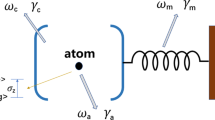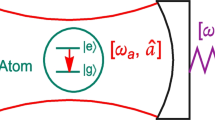Abstract
In this paper, a composed quantum system is investigated which can potentially be used to manipulate the state of a qubit through measurement-based feedback (MBF) control. The composed quantum system consists of a nonlinear single-sided Fabry-P´erot optomechanical cavity cascaded with a 2-level atom and it is driven by a coherent quantum field. Due to the presence of the quantum measurement, the state of the atom needs to be estimated based on the measurement results. The effect of the optomechanical cavity on the state of the 2-level atom is disclosed through a quantum filtering approach. To this end, the SLH framework is utilized to analyze and model the considered composed quantum system. Then, filtering equations of the composed quantum system are derived. Numerical simulations are done for different initial conditions as well as different input quantum fields. In addition, the effects of atom and cavity parameters are studied and the result shows that choosing appropriate values for these parameters can change the behavior of the system in the desired way. The filter simulation results are validated by demonstrating that the average of the estimations for 50 ensembles follows the result from the master equation.











Similar content being viewed by others
Data availability
All data that support the findings of this study are included within the article.
References
Z. Rahimkhani, M. Yaghobi, K. Javidan, Quantum filtering equations for atom-single photon interaction by homodyne detection: considering full interaction Rabi model. Optik (Stuttg) 140, 619–625 (2017)
C. Altafini, F. Ticozzi, Modeling and control of quantum systems: an introduction. IEEE Trans. Autom. Control 57(8), 1898–1917 (2012)
P. Piergentili, L. Catalini, M. Bawaj, S. Zippilli, N. Malossi, R. Natali, D. Vitali, G. Di Giuseppe, Two-membrane cavity optomechanics. New J. Phys. 20(8), 083024 (2018)
L. Bouten, R. Van Handel, M.R. James, An introduction to quantum filtering. SIAM J. Control Optim. 46(6), 2199–2241 (2007)
J. Combes, J. Kerckhoff, M. Sarovar, The SLH framework for modeling quantum input-output networks. Adv. Phys. X 2(3), 784–888 (2017)
S. Qamar, S. Cong, Observer-based feedback control of two-level open stochastic quantum system. J. Franklin Inst. 356(11), 5675–5691 (2019)
A. Dabrowska, G. Sarbicki, D. Chruściński, Quantum trajectories for a system interacting with environment in a single-photon state: Counting and diffusive processes. Phys. Rev. A 96(5), 053819 (2017)
Daeichian, A., Aghaei, S.: Estimating the state of a one-sided quantum cavity driven by vacuum field in Schrödinger picture. In: Proc. 7th Int. Conf. Control Instrum. Autom. (ICCIA2021), pp. 1–5 (2021)
A. Daeichian, Feedback control of quantum systems to stabilize superposition states. IEEE Trans. Autom. Control. (2023). https://doi.org/10.1109/TAC.2023.3237504
Z. Dong, G. Zhang, N.H. Amini, Single-photon quantum filtering with multiple measurements. Int. J. Adapt. Control Signal Process. 32(3), 528–546 (2018)
T. Green, H. Uys, M.J. Biercuk, High-order noise filtering in nontrivial quantum logic gates. Phys. Rev. Lett. 109(2), 020501 (2012)
S.S. Szigeti, A.R. Carvalho, J.G. Morley, M.R. Hush, Ignorance is bliss: general and robust cancellation of decoherence via no-knowledge quantum feedback. Phys. Rev. Lett. 113(2), 020407 (2014)
K. Keane, A.N. Korotkov, Simplified quantum error detection and correction for superconducting qubits. Phys. Rev. A At. Mol. Opt. Phys. 86(1), 012333 (2012)
M.H. Schleier-Smith, I.D. Leroux, V. Vuletić, States of an ensemble of two-level atoms with reduced quantum uncertainty. Phys. Rev. Lett. 104(7), 073604 (2010)
R. Vijay, C. Macklin, D.H. Slichter, S.J. Weber, K.W. Murch, R. Naik, A.N. Korotkov, I. Siddiqi, Stabilizing Rabi oscillations in a superconducting qubit using quantum feedback. Nature 490(7418), 77–80 (2012)
W. Cui, F. Nori, Feedback control of Rabi oscillations in circuit QED. Phys. Rev. A At. Mol. Opt. Phys. 88(6), 063823 (2013)
D. Ristè, C.C. Bultink, K.W. Lehnert, L. DiCarlo, Feedback control of a solid-state qubit using high-fidelity projective measurement. Phys. Rev. lett. 109(24), 240502 (2012)
B. Qi, H. Pan, L. Guo, Further results on stabilizing control of quantum systems. IEEE Trans. Autom. Control 58(5), 1349–1354 (2013)
P. Campagne-Ibarcq, E. Flurin, N. Roch, D. Darson, P. Morfin, M. Mirrahimi, M.H. Devoret, F. Mallet, B. Huard, Persistent control of a superconducting qubit by stroboscopic measurement feedback. Phys. Rev. X 3(2), 021008 (2013)
J. Ma, X. Wang, C.P. Sun, F. Nori, Quantum spin squeezing. Phys. Rep. 509(2–3), 89–165 (2011)
I.D. Leroux, M.H. Schleier-Smith, V. Vuletić, Implementation of cavity squeezing of a collective atomic spin. Phys. Rev. Lett. 104(7), 073602 (2010)
J. Song, Y. Xia, X.D. Sun, Noise-induced quantum correlations via quantum feedback control. J. Opt. Soc. Am. B 29(3), 268–273 (2012)
G. Kießlich, C. Emary, G. Schaller, T. Brandes, Reverse quantum state engineering using electronic feedback loops. New J. Phys. 14(12), 123036 (2012)
R.N. Stevenson, A.R.R. Carvalho, J.J. Hope, Production of entanglement in Raman three-level systems using feedback. Eur. Phys. J. D 61(2), 523–529 (2011)
Y. Li, B. Luo, H. Guo, Entanglement and quantum discord dynamics of two atoms under practical feedback control. Phys. Rev. A At. Mol. Opt. Phys. 84(1), 012316 (2011)
F.E. Becerra, J. Fan, G. Baumgartner, J.T.K.J. Goldhar, J.T. Kosloski, A. Migdall, Experimental demonstration of a receiver beating the standard quantum limit for multiple nonorthogonal state discrimination. Nat. Photon. 7(2), 147–152 (2013)
J. Combes, H.M. Wiseman, K. Jacobs, A.J. O’Connor, Rapid purification of quantum systems by measuring in a feedback-controlled unbiased basis. Phys. Rev. A At. Mol. Opt. Phys. 82(2), 022307 (2010)
G.A. Brawley, M.R. Vanner, P.E. Larsen, S. Schmid, A. Boisen, W.P. Bowen, Nonlinear optomechanical measurement of mechanical motion. Nat. Commun. 7(1), 1–7 (2016)
M. Aspelmeyer, T.J. Kippenberg, F. Marquardt, Cavity optomechanics. Rev. Mod. Phys. 86(4), 1391–1452 (2014)
G.J. Milburn, M.J. Woolley, An introduction to quantum optomechanics. Acta Phys. Slovaca 61(5), 483–602 (2011)
Mansouri, D., Rezaie, B., Ranjbar, A., Daeichian, A.: The dynamic of a quantum optomechanical cavity cascaded with a two-level atom. In: Proc. 7th Int. Conf. Control Instrum. Autom. (ICCIA2021), pp. 1–4 (2021)
W.H.P. Nielsen, Y. Tsaturyan, C.B. Møller, E.S. Polzik, A. Schliesser, Multimode optomechanical system in the quantum regime. Proc. Natl. Acad. Sci. 114(1), 62–66 (2017)
K. Stannigel, P. Komar, S.J.M. Habraken, S.D. Bennett, M.D. Lukin, P. Zoller, P. Rabl, Optomechanical quantum information processing with photons and phonons. Phys. Rev. Lett. 109(1), 013603 (2012)
K. Stannigel, P. Rabl, A.S. Sørensen, M.D. Lukin, P. Zoller, Optomechanical transducers for quantum-information processing. Phys. Rev. A 84(4), 042341 (2011)
C. Dong, Y. Wang, H. Wang, Optomechanical interfaces for hybrid quantum networks. Natl. Sci. Rev. 2(4), 510–519 (2015)
B.D. Hauer, A. Metelmann, J.P. Davis, Phonon quantum nondemolition measurements in nonlinearly coupled optomechanical cavities. Phys. Rev. A 98(4), 043804 (2018)
L. Luo, K. Wang, K. Guo, F. Shen, X. Zhang, Z. Yin, Z. Guo, Tunable manipulation of terahertz wavefront based on graphene metasurfaces. J. Opt. (United Kingdom) 19(11), 115104 (2017)
N. Kralj, M. Rossi, S. Zippilli, R. Natali, A. Borrielli, G. Pandraud, E. Serra, G. Di Giuseppe, D. Vitali, Enhancement of three-mode optomechanical interaction by feedback-controlled light. Quantum Sci. Technol. 2(3), 034014 (2017)
C. Lan, T.J. Tarn, Q.S. Chi, J.W. Clark, Analytic controllability of time-dependent quantum control systems. J. Math. Phys. 46(5), 052102 (2005)
T.P. Purdy, P.L. Yu, R.W. Peterson, N.S. Kampel, C.A. Regal, Strong optomechanical squeezing of light. Phys. Rev. X 3(3), 031012 (2013)
A. Kundu, J.A. Miszczak, Transparency and enhancement in fast and slow light in q-deformed optomechanical system. Ann. Phys. (Berlin) 534(8), 2200026 (2022)
Q. Liao, X. Wang, G. He, L. Zhou, Tunable optomechanically induced transparency and fast-slow light in a loop-coupled optomechanical system. Chin. Phys. B 30(9), 094205 (2021)
A. Daeechian, F. Shekholeslam, Survey and comparison of quantum systems: modeling, stability and controllability. J. Control 5(4), 20–31 (2012)
J.E. Gough, M.R. James, H.I. Nurdin, J. Combes, Quantum filtering for systems driven by fields in single-photon states or superposition of coherent states. Phys. Rev. A At. Mol. Opt. Phys. 86(4), 043819 (2012)
A. Daeichian, F. Sheikholeslam, Behaviour of two-level quantum system driven by non-classical inputs. IET Control Theory Appl. 7(15), 1877–1887 (2013)
D. Mansouri, B. Rezaie, N. Ranjbar, A. Daeichian, Coherent feedback ground-state cooling for a mechanical resonator assisted by an atomic ensemble. Eur. Phys. J. Plus 137(9), 1032 (2022)
D. Mansouri, B. Rezaie, N. Ranjbar, A. Daeichian, Cavity-assisted coherent feedback cooling of a mechanical resonator to the ground-state in the unresolved sideband regime. J. Phys. B 55(16), 165501 (2022)
Y. Guo, K. Li, W. Nie, Y. Li, Electromagnetically-induced-transparency-like ground-state cooling in a double-cavity optomechanical system. Phys. Rev. A At. Mol. Opt. Phys. 90(5), 053841 (2014)
Z.Q. Yin, T. Li, M. Feng, Three-dimensional cooling and detection of a nanosphere with a single cavity. Phys. Rev. A At. Mol. Opt. Phys. 83(1), 013816 (2011)
K. Sala, T. Tufarelli, Exploring corrections to the Optomechanical Hamiltonian. Sci. Rep. 8(1), 1–10 (2018)
S. Zippilli, N. Kralj, M. Rossi, G. Di Giuseppe, D. Vitali, Cavity optomechanics with feedback-controlled in-loop light. Phys. Rev. A 98(2), 023828 (2018)
A.M. Dabrowska, Quantum filtering equations for a system driven by nonclassical fields. Open Syst. Inf. Dyn. 25(2), 18500075 (2018)
A.M. Dąbrowska, Quantum trajectories for environment in superposition of coherent states. Quantum Inf. Process. 18(7), 224 (2019)
B.Q. Baragiola, J. Combes, Quantum trajectories for propagating Fock states. Phys. Rev. A 96(2), 023819 (2017)
M. Rossi, D. Mason, J. Chen, A. Schliesser, Observing and verifying the quantum trajectory of a mechanical resonator. Phys. Rev. Lett. 123(16), 163601 (2019)
Funding
This research did not receive any specific grant from funding agencies in the public, commercial, or not-for-profit sectors.
Author information
Authors and Affiliations
Contributions
Daryoosh Mansouri wrote the main manuscript text and all other authors reviewed the manuscript.
Corresponding author
Ethics declarations
Conflict of interest
The authors declare that they have no known competing financial interests or personal relationships that could have appeared to influence the work reported in this paper.
Additional information
Publisher's Note
Springer Nature remains neutral with regard to jurisdictional claims in published maps and institutional affiliations.
Appendix: Deriving SME equations
Appendix: Deriving SME equations
The procedure of deriving filter equations for \({\sigma }_{z}\) is presented in the following and equations for other operators can be derived similarly.
Substituting \({\sigma }_{z}\) into (8) gives:
Pauli matrices of the 2-level atom can be written as \({\sigma }_{z}=|1\rangle \langle 1|-|0\rangle \langle 0|,\) \({\sigma }_{x}=|1\rangle \langle 0|+|0\rangle \langle 1|\),\({\sigma }_{y}=i(|0\rangle \langle 1|-|1\rangle \langle 0|)\). Substituting these relations into \(-i[{\sigma }_{z},H]\) and simplifying by doing some calculations using \(\langle 1|0\rangle =\langle 0|1\rangle =0\) and \(\langle 1|1\rangle =\langle 0|0\rangle =1\) gives:
Substituting \(L_{1} = \sqrt k a + {\raise0.7ex\hbox{${\sqrt \gamma }$} \!\mathord{\left/ {\vphantom {{\sqrt \gamma } 2}}\right.\kern-\nulldelimiterspace} \!\lower0.7ex\hbox{$2$}}\sigma _{x} - {\raise0.7ex\hbox{${\sqrt \gamma }$} \!\mathord{\left/ {\vphantom {{\sqrt \gamma } 2}}\right.\kern-\nulldelimiterspace} \!\lower0.7ex\hbox{$2$}}i\sigma _{y} + \alpha\) into the drift part of (15) gives:
For \({L}_{2}\) and \({L}_{3}\) we have:
Substituting \({\sigma }_{z}\) and \({L}_{1}\) from (7) to stochastic term of (15) and simplifying gives:
Rights and permissions
Springer Nature or its licensor (e.g. a society or other partner) holds exclusive rights to this article under a publishing agreement with the author(s) or other rightsholder(s); author self-archiving of the accepted manuscript version of this article is solely governed by the terms of such publishing agreement and applicable law.
About this article
Cite this article
Mansouri, D., Rezaie, B., Ranjbar N, A. et al. Optomechanical cavity-atom interaction through field coupling in a composed quantum system: a filtering approach. Appl. Phys. B 129, 58 (2023). https://doi.org/10.1007/s00340-023-07995-z
Received:
Accepted:
Published:
DOI: https://doi.org/10.1007/s00340-023-07995-z




